Prayer Files: preview
My Prayer Files series will be on display this July; here's a preview:
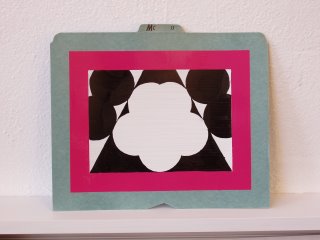
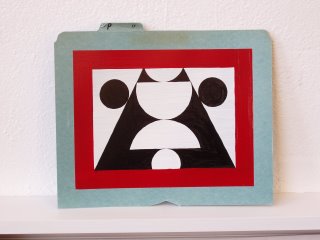
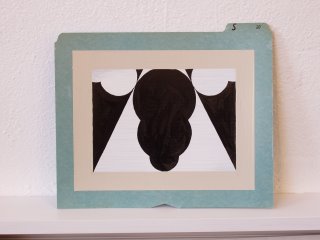
(from top: F, Mc, P, S: all, gesso, india ink, latex and enamel on file dividers)
The Artwork and Writings of P. Timothy Gierschick II
My Prayer Files series will be on display this July; here's a preview:



(from top: F, Mc, P, S: all, gesso, india ink, latex and enamel on file dividers)
 (photo, www.fleisher-ollmangallery.com)
(photo, www.fleisher-ollmangallery.com)
Walking into the new Annabeth Rosen show at Fleisher/Ollman Gallery downtown, I quickly ran through thoughts of viscera and brains, and began to realize that it was more akin to taking orbit within a linear galaxy. Here was a small group of ceramic planetoids; like our galaxy, each one part of a larger whole, but nevertheless wholly their own bulbous selves. In fact, partly because many of them were shallowly elevated on stubby feet, and all topped with some larger single motif or assemblage, they brought to mind ancient Hebrew cosmology: a footed foundation, which, bowl-like, holds the seas; rimmed by land, which pillars up the firmament all around, from which the stars hang, jewel-like.
Each one of these microcosms is a delightful hybrid of the biological and the technological. Hard-edged, extruded shapes, and softer ringlets of worm-pilings are all balled up like an escaped, writhing ramen noodle dish, topped with those more definitive shapes or motifs, suggesting such things as creamy porcelain balloons, arched cement porpoises or barbells, and mutant kohlrabi. Here and there the mostly dun, brown and white glazes are punctuated with painted striping, dots or other purposeful accent. This causes one to wryly wonder, is this a sign of intelligent design on these little planets? Perhaps.
Thinking planetarily of these sculptures made even more sense upon seeing shots of Rosen's studio, shared with me by John Ollman, gallery director. There was the creator, spinning out one after the other of her asteroids into the macro-universe of her studio; stack upon stack, row upon row of accumulated semi-orbs, accompanied by scores of wall-hung works on paper. Here each part of the creative process seemed yet another step in a series of elemental increases: from clay molecules, on to wet ceramic shapes - then a detour of purposeful artifice - and finally on to this curated, galaxial collection.
Through June 10th
Fleisher/Ollman Gallery, 1616 Walnut Street, Suite 100, Philadelphia, PA
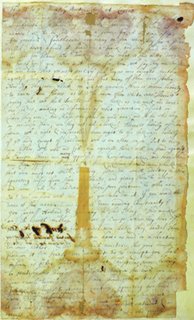 (The 1688 anti-slavery petition. — Photo by Rob Smith / Germantown Monthly Meeting of the Religious Society of Friends)
(The 1688 anti-slavery petition. — Photo by Rob Smith / Germantown Monthly Meeting of the Religious Society of Friends)
This past February, which is Black History month, I posted a transcription of the document which several Germantown Quakers, some of Mennonite background, wrote and signed, in protest against slavery. The actual document had been missing for several decades, and has just been re-discovered in the Arch Street Meeting House, downtown Philadelphia. Here's the article from Mennonite Weekly Review:
http://www.mennoweekly.org/MAY/05-22-06/PETITION05-22.html
And here's my previous post, with some related links:
http://gierschickwork.blogspot.com/2006/02/in-honor-of-black-history-month.html
Peace, y'all.
Here's a recent painting...coming soon, a short review of Annabeth Rosen's ceramics and works on paper exhibit at Fleisher/Ollman. (Keystone Study 4, acrylic on panel, 2006)
(Keystone Study 4, acrylic on panel, 2006)
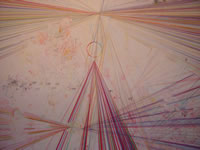 (above, Michelle Oosterbahn, detail of AH-HA, courtesy of Gallery Joe)
(above, Michelle Oosterbahn, detail of AH-HA, courtesy of Gallery Joe)
What is it about paper? For centuries, it’s been a repository for humanity’s dreams, secrets, visions and mundane routines. Our picture of 17th century England gains color due to Samuel Pepys’s journaling; and through James Castle’s ghostly drawings we may enter, ever so slightly, into a recluse’s world. When our minds were full to the bursting, paper was there to be the tabula rasa that we could not. Humans can also identify with paper’s tenuous hold on existence. Like us, paper can be destroyed in a few minutes, but if properly cared for, can last a century or more. Indeed, like us, paper often strives for permanency within its ephemerality – especially when an artist takes the material seriously, and wrings it of all possibility.
In the latest version of Arcadia University’s lauded Works on Paper exhibits, I noticed three apparent dualities that relate closely to human experience, and are seen especially in art on paper: ephemeral, yet striving for permanence; intimate, yet ultimately distant and mysterious; and immediate, yet complex. In these three ways, we may understand partly why humans keep returning to paper, and why it seems to have seduced us as a material.
Michelle Oosterbahn’s drawing AH-HA – done in a style reminiscent of Matthew Ritchie or Julie Mehretu, who was recently featured in the Fabric Workshop’s Swarm – creates a complex, belabored environment, attempting to assert its own or the artist’s permanence through meaningful repetition. And the piece scintillates in a subdued, colored-pencil manner; asking if, indeed, some permanence can be created, is it not through committed persistence?
This repetitive action towards permanence is set into effective relief by Gabriel Martinez’s Blackbird Confetti. Martinez has piled, thousand fold, tiny cutouts of blackbirds on the gallery floor. It’s as if, suddenly failing in their migration, the birds have fallen, en masse, to a mysterious demise. These paper birds could quickly be reduced to a devastated mush – in fact, a point is made of the paper being biodegradable – and yet in their insistent repetition, self-assertiveness has been established, which contributes, if not to longer life, to a certain valor in whatever end this avian group has met.
Several of the pieces in the exhibit read like diaries; undeniably intimate – both through subject and execution – yet absolutely mysterious. There is a perceptual wall that can be seen through only, as a glass, darkly. The individual artist chooses how universal to make their revelations and pronouncements – and it seems that paper fosters mystery, encouraged by its intimacy. That is, because of the subjective nature of the works, their extreme universality – for example, we all had a childhood – bursts through into a profound mysterious state. Which is, of course, necessary to attract us: reading your own diary isn’t nearly as enthralling as reading someone else’s.
Human beings are so often two different creatures: consider first versus second impressions. This idea is also expressed by traumatized family members or neighbors stating on TV “…he was such a nice, quiet man…” This immediacy or simplicity, contrasted with underlying complexity, is evidenced in both Nils Orth’s montaged photographs – in a physical manner – of three teenaged faces, and in a more metaphysical way in Jessica Doyle’s untitled mixed media drawing of a weird park or reunion scene. Both works are immediately recognizable and seem scrutable – until a lingering look tells us something’s awry. There’s a certain neo-surreality to both of these works. Nils Orth, through digital manipulation of various faces into one, has created portraits both Everyman and weirdly alien; they are strange in their non-specificity. A simple portrait has become a complex digitally altered question of reality and veracity. Jessica Doyle’s drawing also seems fairly familiar; the subject and the medium and even setting seem workaday. But upon considering the encroaching sunset, the concerned and self-absorbed stares on the figures’ faces, the drawing turns towards a macabre ennui. This is not a reunion; this is a group of individuals who may themselves be asking, what am I doing here? Why am I with these other people? There is a definite sense of existential doubt…as if drawn from a highly subjective memory of an old picnic snapshot – but the memory has stuck in the artist’s craw, and inky dread has seeped to the surface.
Perhaps one reason we keep turning back to paper, is because like an unavoidable mirror, we continue to see ourselves – our condition – in this equally natural and manmade material; and we must respond.

...or, the Chinese Damien Hirst?
"...Many of China's most successful artists were there, including Mr. Zhou. At the banquet afterward, upstairs at a fashionable restaurant, he strolled among tables, cigarette and wine glass in hand, hugging fellow artists and joining them in toasts. He was now firmly in the inner circle.
Asked how it felt, he grinned and said: 'Ten years ago I wanted to show people how easy it is to make art. And I did that. Now I'm on the list.'..."
full article:
http://www.nytimes.com/2006/05/01/arts/design/01zhou.html?pagewanted=2&_r=1&th&emc=th
Read more...